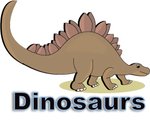Megalosaurus
|
|
of the Jurassic period.
| Contents |
Discovery
Megalosaurus was the first dinosaur ever to be described. A jawbone and teeth were recovered from Oxford, England in 1676. Physician James Parkinson described them in an article in 1822, regarding their study by William Buckland, the famous pioneer of paleontology. Two years later, Buckland published his own complete account of his studies, and it is from him that Gideon Mantell gave the first species of dinosaur its name in 1827: Megalosaurus bucklandi ("Buckland's big lizard"). It is perhaps difficult for us to imagine the significance of this discovery. Never before had it even been imagined that there had existed animals extinct before the advent of mankind. Even the oft-used analogy of discovering extraterrestrial life is not sufficiently powerful - dinosaurs had not even been conceived of before 1822. However, other reptilian wonders of the Mesozoic such as Mosasaurus and Pterodactylus were already known.
Description
Early reconstructions
Since those first finds, many other Megalosaurus bones have been recovered, but still no complete skeleton has been found. Therefore we cannot be certain about the details of Megalosaurus's physical appearance. Early paleontologists, never having seen such a creature before, reconstructed it like the dragons of popular mythology, with a huge head and walking on all fours. It was not until the middle of the nineteenth century, when other theropods began to be discovered in North America, that a more accurate picture was developed. Some confusion still exists, for at one time (before classification of dinosaurs became the serious business it is today) all theropods from Europe were given the title Megalosaurus. Since then, these have been mostly reclassified but older papers are often the cause of confusion. For further confusion, the most reproduced anatomy diagram of Megalosaurus' skeleton was produced before any vertebrae had been recovered. While drawing it, Friedrich von Huene of the University of Tubingeng, Germany, instead used the backbones of Altispinax, a mysterious big theropod known from high-spined dorsal vertebrae and at times classified as a spinosaur. Hence, many later drawings based on his original show Megalosaurus with a deep spinal ridge or even a small sail like that of Spinosaurus.
Modern reconstructions
In fact, Megalosaurus did have a relatively large head and the teeth were clearly that of a carnivore. However, the long tail would have balanced the body and head and so Megalosaurus is now restored as a bipedal beast like all other theropods, and about nine metres in length. The structure of the cervical vertebrae suggests that its neck would have been very flexible. To support its weight of around one tonne, the legs were large and muscular. Like all theropods, it had three forward facing toes and a single reversed one. Although they had not reached the minuscule size of later theropods like Tyrannosaurus, Megalosaurus' arms were small and probably had three or four fingers.
Living in what is now Europe during the Jurassic Period (181 to 169 million years ago), Megalosaurus may have hunted stegosaurs and sauropods. Repeated descriptions of Megalosaurus hunting Iguanodon (another of the earliest dinosaurs named) through the forests that then covered the continent are probably inaccurate, because Iguanodon skeletons are found in much younger Early Cretaceous formations. No fossils assignable to Megalosaurus have been discovered in Africa, contrary to some outdated dinosaur books.
Although Megalosaurus was a powerful carnivore and could probably have attacked even the largest sauropods, it is also likely that it gained some of its food by scavenging. That is not to detract from its prowess as a hunter - Tyrannosaurus probably did much the same. Efficiency was necessary to feed such a large body.
Classification
- Order - Saurischia
- Suborder - Theropoda
- Family - Megalosauridae
Since M. bucklandi, at least two further species of Megalosaurus have been named. Zhao named M. dabukaensis in 1985 and H. P. Powell & Pickering added M. phillipsi in 1995.

